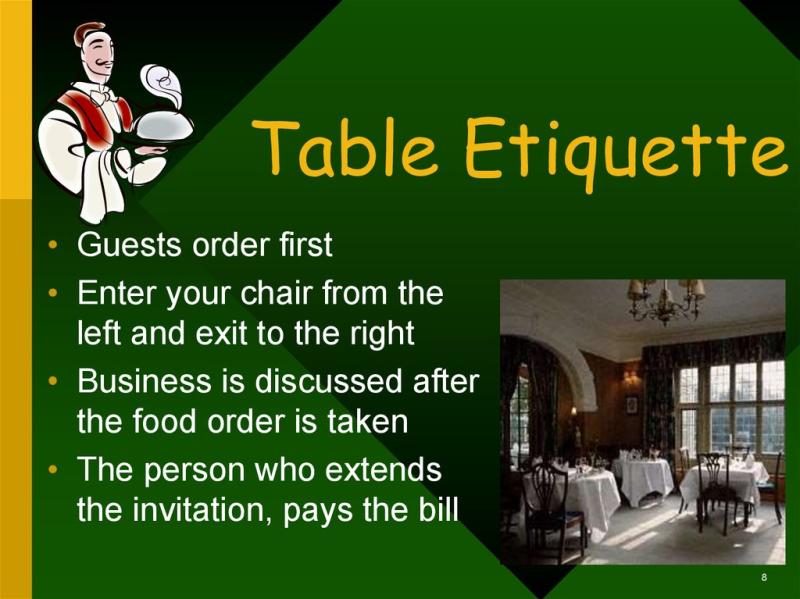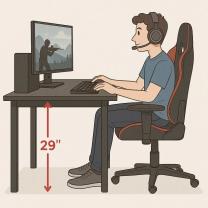What are the table etiquette rules for eating?
Table etiquette, also known as dining etiquette, involves a set of rules and manners that govern behavior during meals. Adhering to proper table etiquette is a sign of respect and consideration for others. Here are some general guidelines for table etiquette:
1. Napkin Etiquette:
- Placement: Place your napkin on your lap as soon as you are seated.
- Use: Use the napkin to wipe your mouth when necessary. Dab, don't wipe, to avoid smearing.
2. Utensil Usage:
- Outside-In Rule: Start with the outermost utensils and work your way in with each course.
- Forks on the Left, Knives and Spoons on the Right: Forks are typically placed on the left side of the plate, and knives and spoons on the right.
3. Holding Utensils:
- European Style: Hold the fork in the left hand and the knife in the right hand throughout the meal.
- American Style: Cut food with the knife in the right hand, then switch the fork to the right hand to eat.
4. Elbows Off the Table:
- Keep your elbows off the table. Rest your wrists on the edge if you are not actively using your utensils.
5. Chew with Your Mouth Closed:
- Chew your food with your mouth closed to avoid making noise.
6. Pace Yourself:
- Pace your eating to match the speed of others at the table. Avoid finishing your meal significantly earlier or later than others.
7. Wait for Others:
- Start eating only after everyone at the table has been served or, if it's a formal setting, when the host signals to begin.
8. Passing Food:
- Pass dishes to your right. If someone requests the salt or pepper, pass both together.
9. Excusing Yourself:
- If you need to leave the table during the meal, say "excuse me" and place your napkin on your chair.
10. Use Polite Language:
- Use polite language when asking for something to be passed or when making requests.
11. Compliment the Chef:
- If you enjoy the meal, it's polite to compliment the chef or host.
12. Cell Phone Etiquette:
- Keep your phone on silent or vibrate. Avoid using it at the table unless it's an emergency.
13. Thank the Host:
- Thank the host or hostess before leaving the table.
14. Toothpicks:
- If you need to use a toothpick, do so discreetly, such as in the restroom.
15. Tasting Wine:
- When tasting wine, hold the glass by the stem and take a small sip. Swirl the wine gently before tasting.
16. Handling Bones:
- If you encounter an unwanted item in your mouth, discreetly use your fork to remove it, and place it on the edge of your plate.
17. Be Mindful of Noise:
- Avoid making excessive noise, such as slurping soup or tapping utensils.
18. Be Respectful:
- Show respect to your fellow diners by engaging in polite conversation and avoiding controversial topics.
Remember that table etiquette can vary across cultures, so it's helpful to be aware of cultural differences when dining in diverse settings. The key is to be considerate, present, and respectful of others at the table.
Proper Posture, Utensil Usage, and Napkin Etiquette
Dining etiquette encompasses a set of manners and customs that enhance the dining experience and promote social grace. Proper posture, utensil usage, and napkin etiquette are fundamental aspects of formal dining etiquette.
Posture:
- Sit upright with your back straight and shoulders relaxed.
- Avoid slouching or hunching over your plate.
- Keep your elbows off the table while dining.
Utensil Usage:
- Hold your utensils with a relaxed grip, using your thumb and forefinger to control the movement.
- When cutting food, use a sawing motion rather than a chopping motion.
- Bring food to your mouth; do not lean forward to reach your food.
- Never use your fingers to pick up food from serving dishes or your plate.
- When taking a break from eating, rest your utensils on the side of your plate, not balancing them on your plate or napkin.
Napkin Etiquette:
- Unfold your napkin completely and place it on your lap.
- Use your napkin to discreetly wipe your mouth and fingers throughout the meal.
- Avoid using your napkin to blow your nose or wipe your face.
- When leaving the table temporarily, fold your napkin and place it on your chair or the side of your plate.
Polite Conversation and Dining Behaviors at the Table
Engaging in polite conversation and maintaining proper dining behaviors enhance the social aspect of dining and demonstrate respect for your fellow diners.
Conversation:
- Engage in active listening, maintain eye contact, and show genuine interest in the conversations around you.
- Avoid interrupting others or dominating the conversation.
- Keep your voice at a reasonable level to avoid disturbing others.
- Avoid controversial or sensitive topics that could cause discomfort or offense.
Dining Behaviors:
- Wait for everyone at the table to be served before starting to eat.
- Take small bites and chew with your mouth closed.
- Avoid making loud noises while eating or drinking.
- Refrain from using your phone or other electronic devices at the table.
- Excuse yourself politely when leaving the table or reaching for something out of reach.
Cultural Considerations and Adapting Table Etiquette Practices
Table etiquette varies across cultures, and being mindful of these differences demonstrates respect and cultural sensitivity.
- Familiarize yourself with the basic dining customs of the culture you are engaging in.
- Observe the practices of your fellow diners and follow their lead when unsure.
- Ask politely for clarification or guidance if you are unfamiliar with a particular custom.
- Be open to trying new foods and dining experiences.
- Express gratitude for your host's hospitality.










